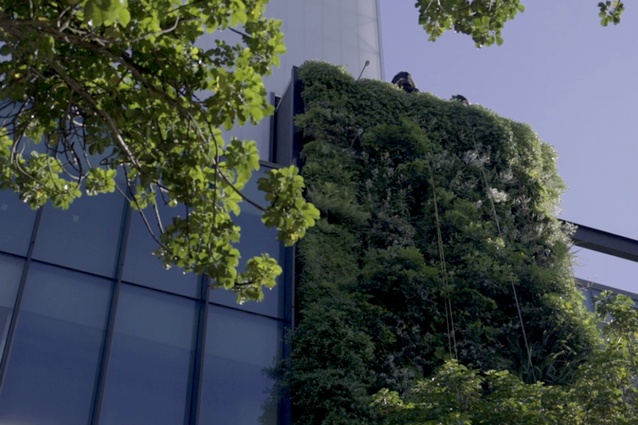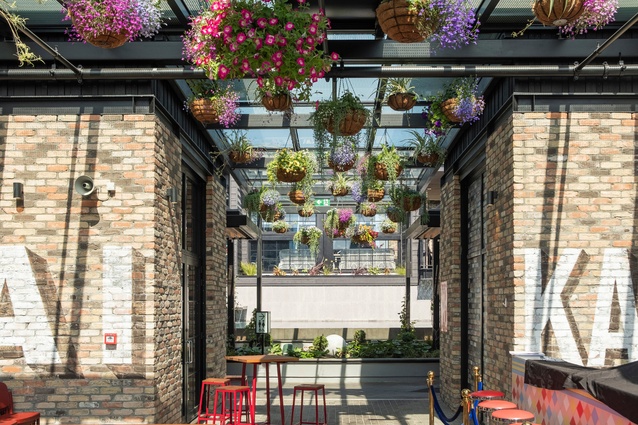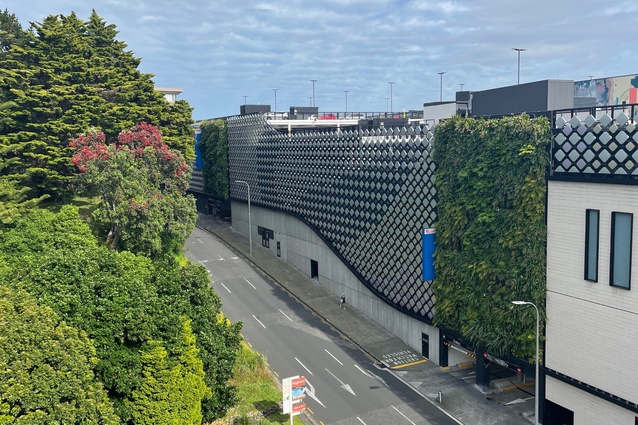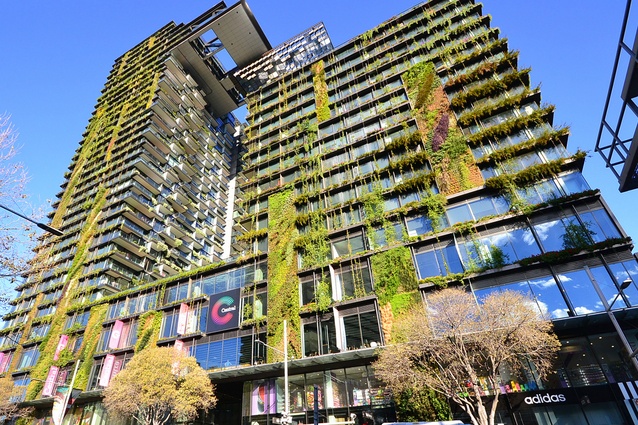The compelling case for green roofs and walls: Part 2, commercial, social, and political
Westfield Newmarket is known as being one of Auckland’s retail meccas. Beyond the bustling tenancies, it’s also appreciated by a different kind of visitor. Thanks to multiple and multi-level green walls (which form one part of its intensive exterior gardens), this shopping destination is also helping nurture biodiversity.
While the benefits of weaving nature into interior spaces are well-documented (particularly within a workplace setting), international legislation shows a growing recognition for the compelling social opportunities that come from exterior greenery. These types of projects often involve developing exciting and innovative solutions — where architects can develop a unique point of difference.
Biophilia in the retail sector
In a retail setting, international research has found that consumers are likely to stay longer when restorative greenery is introduced, and it can contribute to improved mood among shoppers.3 This greenery can take various forms and functions.
Sustainable gardening at Sylvia Park Shopping Centre ranges from vegetable planter beds to rainwater capture and filtration. Compost (which uses food waste from the Centre’s food outlets) replenishes the site. Planting extends throughout the interior and is a feature around dining areas. In the outdoor areas, planting includes approximatly 350 trees and 5,000 shrubs.
Westfield Newmarket is a great example of intensive exterior gardens. Green walls cascade across various façades (including car parking entries). You’ll find rooftop gardens, hanging plants, mature trees, shrubs, and extensive interior planting. The exterior planting has the added benefit of supporting biodiversity and cooling the air. In 750m2 of green wall, you’ll find over 18,000 plants.
Derby Square at Takanini Town Centre is one of the newest examples of the merging of retail with greenery in Auckland. The project scope includes a landscaped ‘Town Square’ with buildings opening directly onto green areas. Its emphasis on green areas as an essential component of a boutique shopping precinct, demonstrates a seachange in public perception.
There has been a recognition over the last few years that, while the purpose of a retail development is to present spaces to sell things, it is the experience that people have while they are there that is just as important. That experience starts at the entrance where you drive in. A green wall transforms these types of functional areas into a feature. In the case of Westfield Newmarket, this development features six of them.
Many retail projects in New Zealand are relatively old and built when green façades and green roofs were relatively unknown and certainly not the norm. It will be interesting to see how the sector continues to adopt the many opportunities that come from facilitating access to nature.
Benefits to architects and clients
The introduction of Green Star and WELL certification, and favourable ‘green’ lending terms for developers, are some of the drivers behind the growth of biophilic-led projects in New Zealand.
A unique skill set is required to design with sustainable outcomes in mind, where buildings and fit-outs are future-proofed. This can create a distinct point of difference for a studio. Architects can achieve much professional satisfaction knowing their projects have a positive impact on the environment and our communities.
Prioritising biophilic principles often involves developing innovative solutions. It can allow nature to be incorporated without expanding the footprint — in the case of green walls.
Technical knowledge is necessary to get it right by understanding specification and maintenance requirements. These projects need to succeed for many years, and in many ways, if they are to be of any value to developers and communities.
In addition, workplace designs that prioritise access to nature can be linked to achieving increased staff productivity, well-being, and retention, increasing ROI.1
Planning for green roofs and green walls
Sydney’s One Central Park features over 1,000m2 of vertical garden using more than 380 plant species (many of which are native to Australia). The planning for greenery on this scale included detailed metrological assessments.2
While it’s a landmark green exteriors project, One Central Park highlights the importance of planning for green roofs and exteriors to achieve the optimal outcome. Using trained professionals is key and, at a minimum, should include:
- A weather assessment
- Examining the positioning of the building and identifying areas most vulnerable to heat, wind, and shade
- Considering the impact of the surrounding buildings
- Ensuring the greenery can be easily (and safely) maintained
Careful selection of plants is critical. In harsh, wind-exposed, and north-facing environments, hardy, drought-resistant plants should be the preferred option. On the cooler south-facing aspects, green walls could include species such as ferns and other shade-tolerant species. For any green wall project, consideration should always be given to maximising biodiversity.
Legislating for change
Government incentives are driving the adoption of green exteriors internationally. These are very much linked to the recognition of climate impact and the need to control or mitigate this in some way.
The landscaping requirements for new developments in Singapore (known as Landscape Replacement Areas or LRA) is 100% of the development site — 40% of that must be greenery. Green walls meet the LRA criteria. The Government also offers a generous rebate of 50% on these parts of the development.4
France introduced a law in 2022 mandating that all new commercial developments must have green roofs or solar panels (and the two are not mutually exclusive). The requirement is 30% of the roof cover, with the developer having the choice of how this is presented.5
The US has several organisations active in the promotion of green walls and roofs. There has been a steady increase over the last few years of cities and states within the US and Canada implementing green building policies. Most of these seem to be state or local Government initiatives.6
In the UK last year, a Bill was passed implementing Biodiversity Net Gain (BNG) to create and sustain areas for nature. Within urban environments, green walls and roofs can create these types of areas. The importance of this legislation is its requirement to achieve a BNG for 30 years.7
However in New Zealand, the Government nor local councils are yet to encourage, promote or incentivise the addition of green roofs or living walls in new builds or retrofits despite New Zealand’s commitment to reaching net-zero carbon emissions by 2050.
References
1. Ryan, C., Browning, W., & Walker, D. (2023). The Economics of Biophilia, 2nd ed.: Why designing with nature in mind makes financial sense. New York: Terrapin Bright Green, LLC. http://www.terrapinbg.com/report/eob-2 (Accessed: 1 March 2024)
2. (n.d.). One Central Park, Sydney: The green walls are the tallest such installations in the Southern Hemisphere. ARUP. https://www.arup.com/projects/one-central-park (Accessed: 12 February 2024).
3. Ryan, Browning, & Walker. (2012) The Economics of Biophilia: Why designing with nature in mind makes financial sense. (1st Ed.) Terrapin Bright Green LLC.
4. (2022, November 29). Sports and Recreation: Greenery. Urban Redevelopment Authority. https://www.ura.gov.sg/Corporate/Guidelines/Development-Control/Non-Residential/SR/Greenery (Accessed: 17 February 2024).
5. Rousset-Rouvière, S. (2022). In France, a New Law Supports Green Roofs on Buildings. Living Architecture Monitor. https://livingarchitecturemonitor.com/articles/france-new-law-supporting-green-roofs-sp22 (Accessed: 18 February 2024).
6. Greenroofs.com. (search=legislation) https://www.greenroofs.com/search/?q=legislation (Accessed: 17 February 2024).
7. Editor. (2024, February 12). Biodiversity Net Gain is now the law: this is how living walls and roofs help developers meet BNG. Pritchard & Pritchard. https://green-roofs.co.uk/biodiversity-net-gain-bng-living-roofs-walls/#:~:text=This%20means%20developers%20need%20to,the%20Environment%20Bill%20of%202021 (Accessed: 17 February 2024). 7. (n.d.). One Central Park, Sydney: The green walls are the tallest such installations in the Southern Hemisphere. ARUP. https://www.arup.com/projects/one-central-park (Accessed: 12 February 2024).












